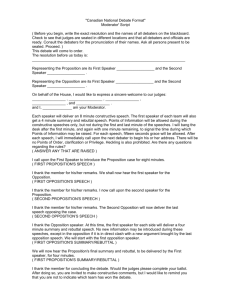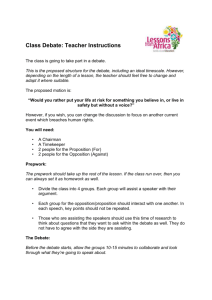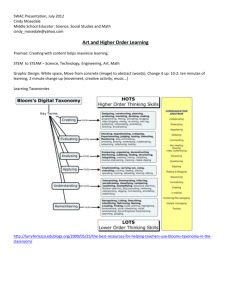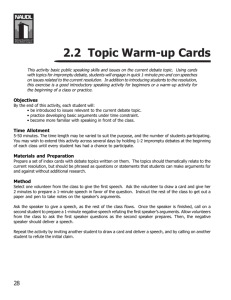Debate Packet - Ms.A Has A Blog
advertisement
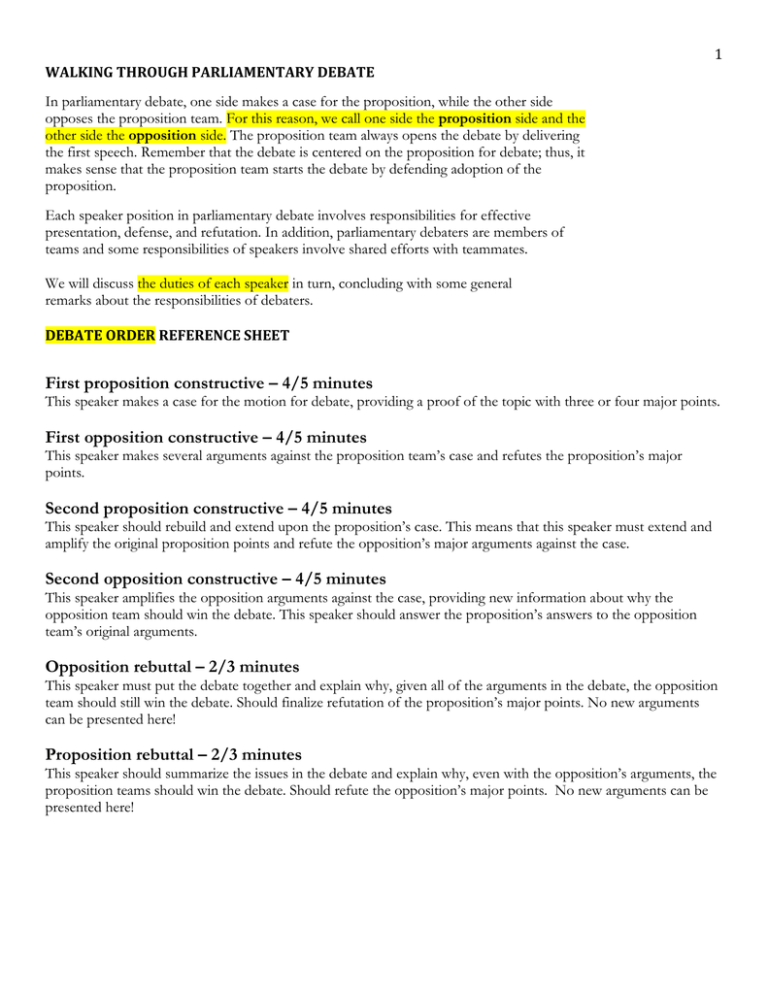
1 WALKING THROUGH PARLIAMENTARY DEBATE In parliamentary debate, one side makes a case for the proposition, while the other side opposes the proposition team. For this reason, we call one side the proposition side and the other side the opposition side. The proposition team always opens the debate by delivering the first speech. Remember that the debate is centered on the proposition for debate; thus, it makes sense that the proposition team starts the debate by defending adoption of the proposition. Each speaker position in parliamentary debate involves responsibilities for effective presentation, defense, and refutation. In addition, parliamentary debaters are members of teams and some responsibilities of speakers involve shared efforts with teammates. We will discuss the duties of each speaker in turn, concluding with some general remarks about the responsibilities of debaters. DEBATE ORDER REFERENCE SHEET First proposition constructive – 4/5 minutes This speaker makes a case for the motion for debate, providing a proof of the topic with three or four major points. First opposition constructive – 4/5 minutes This speaker makes several arguments against the proposition team’s case and refutes the proposition’s major points. Second proposition constructive – 4/5 minutes This speaker should rebuild and extend upon the proposition’s case. This means that this speaker must extend and amplify the original proposition points and refute the opposition’s major arguments against the case. Second opposition constructive – 4/5 minutes This speaker amplifies the opposition arguments against the case, providing new information about why the opposition team should win the debate. This speaker should answer the proposition’s answers to the opposition team’s original arguments. Opposition rebuttal – 2/3 minutes This speaker must put the debate together and explain why, given all of the arguments in the debate, the opposition team should still win the debate. Should finalize refutation of the proposition’s major points. No new arguments can be presented here! Proposition rebuttal – 2/3 minutes This speaker should summarize the issues in the debate and explain why, even with the opposition’s arguments, the proposition teams should win the debate. Should refute the opposition’s major points. No new arguments can be presented here! 2 FIRST SPEAKER, PROPOSITION (a.k.a., “ first prop constructive”) The opening speaker in the debate makes a case for the proposition. To make a case, a speaker offers a logical proof, a demonstration that the proposition for debate is more probably true than false. The first speaker for the proposition interprets the topic for debate, defining any unclear terms or otherwise clarifying the foundation for argument. This first proposition speaker may offer a brief history of the issue for debate. Parliamentary debate topics come from a wide variety of areas. Your judges or audience will probably not have precisely the same knowledge base as you. If you provide a history of the issue in controversy, you will assist the judge so that everyone in the debate is on the same page or has the same background information. After the opening speaker provides a clear foundation for the debate, she presents a case, that is, a group of arguments that support of her interpretation of the proposition. The case for the proposition typically consists of three or four main arguments with corresponding examples or other forms of contemporary or historical evidence. You make a case for different propositions in everyday discussions but have probably never thought of your arguments in these terms. How do you convince your friends to go and see a particular movie? You offer several lines of argument, or reasons to prefer your choice of movie. This is called making a case for your position. The first proposition speaker must prove the proposition for debate. The case for the proposition will typically consist of three or four major arguments, with corresponding examples or other forms of contemporary or historical evidence. For example, on the motion, “This House would remove junk food from schools,” an opening speaker might organize her major arguments in the following manner: 1. Eating junk foods like soda and chips causes obesity, diabetes, and heart disease. 2. When students eat a lot of high-sugar foods during the day, that hurts their ability to pay attention and increases the likelihood that they will fall asleep in class. 3. Banning junk food in the schools will be an important step towards solving these problems, because students will eat healthier foods in their cafeterias. The opening speaker should have enough reasons and examples to make concise, complete, and compelling arguments on each of these issues. At the end of her speech, the speaker should remember to offer a summary of her speech to show how her arguments prove the proposition for debate. 3 FIRST SPEAKER, OPPOSITION (a.k.a. “first opp constructive”) The opposition team provides clash in the debate. Clash, one of the fundamental principles of any kind of debate, is simply what happens when arguments directly oppose each other, or clash against each other. The opposition team provides clash when they attempt to undermine the logic of the proposition team’s case. The opposition argues that the topic, as interpreted by the proposition team, does not hold. The first opposition speaker uses tactics of direct and indirect refutation to counter the proposition team’s case. The opening speaker for the opposition may challenge the definition of the motion or the proposition’s decision framework of the debate. The first opposition speaker may also challenge the main arguments of the proposition’s case. The opening speaker for the opposition should critically evaluate the first proposition speaker’s main arguments, pointing out inconsistencies, gaps in logic, argument fallacies, improper causal chains and exaggerated claims. This speaker might also offer counters to the examples presented in the proposition case. You practice indirect argumentation when You should also bring up critical issues that involve issues that are not formally included in the proposition team case. For example, if the first proposition speaker makes an argument for massively increasing funding to schools nationwide but fails to deal with the potential impact such a policy might have on the finances of the nation, you might bring up this problem in your speech. The best first opposition speakers must carefully select opposition arguments that will be relevant and effective for proving that the proposition, as interpreted by the proposition team, is more likely false than true. The opposition does not have to disagree with every argument that the proposition team makes in their case. This strategy is not effective and can be tiresome for a captive audience. Often, it is a good idea if the opposition team agrees with a proposition argument. This practice, called strategic agreement, can help the opposition team focus the discussion on those points that they feel are critical for winning the debate. In the opening speech, opposition debaters should at least account for all the major arguments of the proposition case. The opening opposition speaker should do this in a forthright and formal manner, making it obvious to the judge that they have dealt with all the major elements of the proposition case. The first opposition speaker should say something about each of the major issues of the case. Make sure that the first opposition speech communicates to the judge that the opposition team has a credible and strong strategy for defeating the proposition case. First impressions matter in debate as well as in life. Even if you are unsure of your arguments, it is important that you always sound credible and effective. This confidence may not come easily at first, but with practice you will sound more and more confident. 4 Basically, the opening opposition speaker should try to identify and flesh out two or three main lines of argument against the proposition case. Some of them can be against the proposition, some newly introduced by the opposition. Using the example of the school junk food case given above, an opening opposition speaker might advance the following three lines of argument: 1. Banning junk food will not solve the problem, because students will just go off campus or to vending machines to get their sugary, high-fat snacks. 2. The problem is not junk food; the problem is actually that students don’t get enough exercise. The proposition’s case does not deal with the root cause of the problem. 3. Banning junk food will only make the problem worse – schools will lose money from food providers like Taco Bell. That money pays for gyms and field trips as well as other activities that keep students healthy. 5 SECOND SPEAKER, PROPOSITION (a.k.a., “Second prop constructive”) The second constructive speech for the proposition team is that team’s last opportunity to introduce new arguments and issues. The only stand on the floor for the proposition, after this constructive speech, is the final rebuttal speech in the debate. This is a particularly important speech for the proposition, as it immediately precedes two consecutive opposition speeches, called the opposition block. The “opposition block” is composed of the second opposition constructive speech, and the opposition rebuttal speech. The second speaker for the proposition must answer all of the major objections to the case offered by the opening speaker for the opposition. In addition, this speaker must reestablish the principles of the case as initially presented by her colleague in the first proposition speech. In doing so, she might supplement her colleague’s reasoning, offer additional examples or otherwise amplify the opening presentation. The second proposition speaker must address the proposition’s claims specifically and in order. Let’s imagine that you were the second proposition speaker in the hypothetical junk food debate we’ve been following for the last few pages. How would you go about answering the opposition’s arguments and rebuilding your case to prepare for the coming opposition arguments? First, you would begin your speech by briefly summarizing the arguments that your side has already made for the proposition. After this introductory phase of your speech, you would then proceed to answer the arguments made by the opposition, using those arguments as opportunities to further solidify and expand your case. You might begin this process by saying: “They say that students will just go off campus to buy food, but.…” After you provide a response to their first argument, you should move to their second: “They say that the real problem is a lack of exercise, but banning junk food is a good first step….” You can see from this example how your refutation of the opposition’s arguments might proceed. It is important to make sure that you correctly allocate your time in this speech. Make sure that you allow yourself enough time to appropriately address all of the opposition’s arguments. After you have refuted all of the arguments advanced by the opposition, the second proposition constructive speaker should remember to close with an appropriate conclusion. This usually includes some sort of summary of the debate thus far, where the speaker explains why the proposition should win the debate despite all of the arguments made by the opposition up to this point. 6 SECOND SPEAKER, OPPOSITION (a.k.a., “ second opp constructive”) This is the final constructive speech in the debate for the opposition team. No new arguments or issues may be introduced after this speech. The second speaker for the opposition has several options for her speech. She may continue the objections of the first opposition speaker to the proposition team’s case; present new arguments against the proposition team (these arguments may be either direct or indirect refutation); and evaluate inconsistencies between the arguments of the first and second proposition speakers. It is important to expand the arguments from the first opposition speaker. It is equally important to answer or account for the key issues of the second proposition speaker. The opposition team, in their second speech, should be careful about introducing new arguments or unnecessarily expanding arguments in the debate. The second opposition speaker should effectively summarize issues, explaining carefully the impact of each argument. An argument’s impact is the way an argument plays a decisive role in the outcome of the debate. The “therefore” step in the four-step refutation method is a way of impacting an argument. 7 OPPOSITION REBUTTALIST This is the summary speech for the opposition team, the last opportunity this side will have to explain winning arguments. Rebuttals are an opportunity to contrast the main lines of argument of the proposition and opposition. The speaker should select from among the issues of the debate. It is not possible to cover every argument in the debate. There are likely to be too many argument points from the constructive speeches in the debate, and the rebuttalist has approximately one-half the allotted time of the constructive speakers. The opposition rebuttal speaker should focus attention on the critical two major issues that might tip the debate to the opposition side. The opposition should select more than one issue. Multiple, independent winning arguments may increase the probability that the opposition will succeed in the debate. These arguments must have a foundation in the constructive speeches. New arguments should not be introduced in the opposition rebuttal. The opposition rebuttalist should carry through important issues from her opening speech in the debate, as well as her partner’s constructive speech. However, the speaker should not just repeat arguments from the second opposition constructive speech, as this is not an effective use of time. 8 PROPOSITION REBUTTALIST The proposition has the final speech in the debate. This speech should effectively summarize the entire debate. The proposition rebuttalist has similar goals as the final opposition speaker. The final rebuttalist should extend the arguments from the constructive speeches, taking care to answer the major arguments from the opposition speakers, particularly the final opposition stand on the floor. The proposition rebuttalist should offer multiple, independent proofs of the topic to increase the probability that any single idea will be enough for a victory. The proposition rebuttalist can answer any new arguments that were made in the second opposition constructive speech, because the final rebuttal is the first opportunity in the debate that the proposition team has to refute these issues. Although the answers to the new arguments of the second opposition speaker may appear to be “new,” they are not new arguments in the debate. They have their foundation in a constructive speech. 9 SHOWING SUPPORT IN DEBATE A Point of Information (also known as a POI, pronounced “P-O-I”) A point of information is a question or statement offered by a debater who does not currently hold the floor, presented to the debater who currently holds the floor. Points of Information may be accepted or rejected by the speaker. If a point is accepted by the speaker, the opposing team’s point may not last longer than 15 seconds. The speaker accepts only a single point at a time. The person making a Point of Information may not interrupt the speaker’s answer to the point, make a two-part question, ask a follow-up question, or make any other comment unless the speaker agrees to it by accepting another Point of Information. If you accept the POI, they may speak for up to 15 seconds and may ask a question or present a statement, EXAMPLE: You: “….And so, as you can see, it is a good idea to let fast food franchises into our public schools to provide lunches for students.” Your Opponent: [rises and waits with hand signal] You: “I’ll take your point” Your Opponent: “But those fast food lunches will be less nutritious and therefore less healthy for the students who will eat them.” A heckle is an interruption of a speaker during her presentation. Responsible heckling is not only permitted, but also encouraged, in the MSPDP style. Students heckle to applaud teammates and opponents before and after their speeches. This is done by lightly pounding on a desk or tabletop. Debaters may also cheer the good arguments of their teammates and show their displeasure with some of the opinions of their opponents. During a partner’s speech, it is appropriate to lightly slap the table in support of a particularly clever or winning argument. The members of the team supporting the speaker may also add a shout of “Hear! Hear!” to the pounding. Remember–pounding on the table is applause. Debaters would not cheer and boo a speaker at the same time. Points of Information and heckling are included in the MSPDP format to encourage impromptu argumentation and advanced public speaking skill development. They make the debate exciting, interactive, and fun. Debaters can use these techniques long after their speaking time in the debate is over. It lets debaters stay involved in the debate both before and after their speeches. Points of Information and heckling should be used strategically to show the judge that your opponent cannot defend an argument or has made an error during a speech. Heckling can show support for particularly good arguments made by your teammates. These techniques should be used carefully, however, and may never be used to distract a speaker or continually interrupt a presentation. Debaters should not get carried away with using POIs and heckling. A judge may deduct individual speaker points for rude behavior during an opposing team’s speeches. A judge may also reward individual speakers and teams for the effective use of Points of Information and heckling. 10 VOCABULARY As you read articles, find information, and read the debate rules, when you encounter the unknown word, write it on this worksheet, make a guess on the word’s meaning based on context clues, then look up the word’s actual meaning. Word 1. 2. 3. 4. 5. 6. 7. 8. 9. 10. Possible Meaning Actual Meaning Person Who Found Word 11 Refutation To win a debate, you must show both why you win and why the other team’s arguments don’t mean that you lose. That is, you must argue both offensively and defensively to win a debate, particularly in the rebuttal speeches. To dispute an argument effectively, you must master the skill of refutation. Arguments of refutation answer arguments that are already in play. Refutation is necessary in debates because it promotes direct clash between arguments. The first, and unfortunately most common, way of refuting an argument is simply to provide a counterclaim: Speaker 1: Bananas are better than oranges because they contain more potassium. Speaker 2: Speaker 1 says that bananas are better than oranges, but I disagree. Oranges are better than bananas because they contain more vitamin C. Therefore, you should prefer oranges because while many foods in an ordinary diet contain potassium, few contain an appreciable amount of vitamin C. It is more important to eat oranges whenever possible than it is to eat bananas. Speaker 2 wins. She has completed the process of refutation by including a “therefore” component in her response. Notice how this last part of her argument works. She compares her reasoning to Speaker 1’s reasoning to show why her argument is better than her opponent’s. All basic refutation can follow the basic four-step method above. As you practice your refutation skills, consider starting with this model: Step 1: “They say….” It is important to reference the argument you are about to refute so that your audience and judges can easily follow your line of thought. Unlike the bananas/oranges example above, debates contain many different arguments. Unless you directly reference which of these arguments you are dealing with, you risk confusion on the part of your audience and judge, and confusion is seldom a good technique for winning debates. Good note-taking skills, will help you track individual arguments and the progression of their refutation. One important thing to remember here is that if you were to repeat all of your opponent’s arguments, you wouldn’t have any speech time to advance arguments of your own. So try and rephrase the argument you’re about to refute in just three to seven words to maximize your speech time: “They say that reducing welfare benefits helps the economy, but…;” or “They say Batman is better than Superman, but…” Step 2: “But I disagree….” In this part of your refutation, you state the basics of your counter-argument. This can be, in the case of the banana/orange controversy, simply the opposite of your opponent’s claim. It can also be an attack on the reasoning or evidence offered for your opponent’s claim. The important thing is to state clearly and concisely the counterargument you want the judge to endorse. You can elaborate on it later. For now, it is important to phrase your argument as concisely as possible. This tactic helps your judge, audience, and opponents to remember it and get it in their notes. Step 3: “Because ….” Having advanced your counter-argument, you need to proceed to offer reasoning. Arguments of refutation need to be complete, just like arguments of advancement. Your reasoning can be independent support for your counter-claim, as in the case above. It can also be a reasoned criticism of the opposition’s argument. Step 4: “Therefore….” Finally, you need to draw a conclusion that compares your refutation to your opponent’s argument and shows why yours effectively defeats theirs. This conclusion is usually done by means of comparison, either of reasons or evidence or both. You need to develop a variety of strategies for argument comparison and evaluation, as this is a critical skill for success in competitive debate. What you need to accomplish here is to show that your argument is better than their argument because…. It’s better reasoned. Perhaps their argument makes some kind of error in logic or reasoning, of the kind discussed in the unit on logical fallacies. • It’s better evidenced. Maybe your argument makes use of more or better evidence. Perhaps your sources are better qualified than theirs, or your evidence is more recent than theirs. • It’s empirical. When we say that an argument is empirically proven, we mean that it is demonstrated by past examples. Perhaps your argument relies on empirics, while theirs relies on speculation. • It takes theirs into account. Sometimes your argument may take theirs into account and go a step further: “Even if they’re right about the recreational benefits of crossbows, they’re still too dangerous for elementary school physical education classes.” • It has a greater expressed significance. You can state that your argument has more significance than their argument because (for example) it matters more to any given individual or applies more to a larger number of individuals. • It’s consistent with experience. Perhaps your argument is consistent with experience over time, a in different place, or in different circumstances. This technique is particularly effective with audiences: “Hey, this is something we can all relate to, right?”


